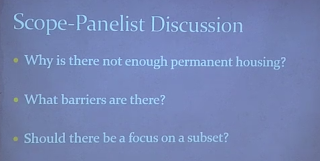 |
| West Coast Mayors |
Revised: December 2018
By Sarah Owens and Michael Livingston
[Originally posted under the title, "MWHITF: Before we try to solve the homeless problem."]
Remember the west coast Mayors' summit on homelessness that took place a few months ago? One of their conclusions was that "We don't have enough data to even understand what is causing the homelessness we have in the streets of our cities, so data is one of the things we want to do better."
The Mid-Willamette Homeless Initiative Task Force would seem to have the same problem.
"Before we try to solve the homeless problem," said the acting Chair at the task force's first meeting, "we need some very basic information." She then posed eight questions:
1. Who are the homeless in Marion and Polk Counties?The task force was given some numbers from the 2015 homeless count, but while that census is generally acknowledged to be the best method for developing valid trend data, it might not be the best source of information for the task force's purposes. Researchers say that the question of how many people are homeless "is both misleading and nearly impossible to answer in any precise way."
2. Who are the chronically homeless in Marion and Polk Counties?
3. Is there a standard definition of a "chronically homeless" individual compared to a "homeless" individual?
4. Is it important to make the distinction and why?
5. How many homeless people are there in Marion and Polk Counties?
6. Who counts the numbers and how are they counted?
7. Why with all the low-income housing, Section 8 vouchers, grants, etc., can we not place anyone who needs a permanent home into a permanent home?
8. What barriers do homeless people encounter and what services or tools do we currently have to address them?
question — “How many people are homeless?” — is both misleading and nearly impossible to answer in any precise way, - See more at: http://journalistsresource.org/studies/government/health-care/homelessness-u-s-trends-demographics#sthash.MO3WqIS8.dpuf
There was a panel of experts to help out with last two questions. Below is a recap of what was said.  |
| Questions for the Panel |
 |
| Andy Wilch, SHA Admin |
In other words, the problem is demand. Wilch also cited data from the recent Salem Housing Needs Assessment that, of the 57,000 households in the Salem MSA, 37% earn $35,000 or less, "so it's an economic issue, as well." He also pointed out that "hard to house" populations cannot compete in the marketplace.
 | |
| Shelly Wilkins-Ehenger |
 |
| Linda Strike, ARCHES |
Linda Strike with the Mid-Willamette Valley Community Action Agency said the clients in the ARCHES programs "like Section 8" had had similar problems trying to rent "even though we would pay for them." She identified having a criminal history or a "very bad rental" history as barriers. She said MWVCAA has a program designed to help homeless individuals overcome such barriers, but the funding for it was coming to an end.
 |
| Craig Bazzi, CARS |
Chief Moore commented that he suspected there are a lot of homeless folks who're not even on a housing voucher waiting list or in some sort of program "like Section 8."
It's not clear whether the Chair was satisfied with the answers she received. The west coast mayors ultimately decided to pool their money to develop a template and collect data. "Beyond data collection, the mayors also hope to study specific programs from each city – such as San Francisco's Navigation Center." How the task force plans to approach its work remains to be seen.
No comments:
Post a Comment